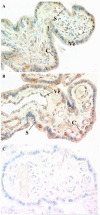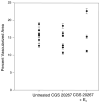Placental villous vascular endothelial growth factor expression and vascularization after estrogen suppression during the last two-thirds of baboon pregnancy
- PMID: 17906373
- PMCID: PMC2689620
- DOI: 10.1007/s12020-007-0036-5
Placental villous vascular endothelial growth factor expression and vascularization after estrogen suppression during the last two-thirds of baboon pregnancy
Abstract
We have recently shown that placental cytotrophoblast vascular endothelial growth factor (VEGF) expression and vessel density were increased by elevating estrogen and decreased by suppressing estrogen in early baboon pregnancy. The present study determined whether the elevation in estrogen which occurs in the last two-thirds of baboon pregnancy also has a role in the regulation of placental villous VEGF expression and angiogenesis. Placentas were obtained on day 170 of gestation (term, 184 days) from baboons untreated or treated with the aromatase inhibitor CGS 20267 or CGS 20267 plus estradiol daily on days 30-169. Serum estradiol levels in CGS 20267-treated baboons were decreased (P < 0.001) by 95%, however, placental cytotrophoblast VEGF mRNA levels (means +/- SE, attomoles/microg RNA) were similar in untreated (25,807 +/- 5,873), CGS 20267-treated (23,900 +/- 1,940) and CGS 20267 plus estradiol-treated (26,885 +/- 2,569) baboons. VEGF mRNA levels in the syncytiotrophoblast (2,008 +/- 405) and inner villous stromal cell (1,724 +/- 287) fractions of untreated baboons also were not altered by CGS 20267. However, whole villous VEGF mRNA levels in CGS 20267-treated baboons (18,590 +/- 2,315) were 4-fold greater (P < 0.001) than in untreated animals and restored to normal by estradiol. Percent vascularized area (15.88 +/- 0.88%) and vessel density (1,375 +/- 71/mm(2)) of the villous placenta in untreated animals were not altered by estrogen deprivation. We propose that villous cytotrophoblasts lose their responsivity to estrogen and that placental villous cytotrophoblast VEGF expression and angiogenesis are regulated by estrogen in a cell- and gestational age-specific manner, and that factors other than estrogen maintain VEGF expression in the last two-thirds of pregnancy.
Figures







Similar articles
-
Regulation of placental vascular endothelial growth/permeability factor expression and angiogenesis by estrogen during early baboon pregnancy.J Clin Endocrinol Metab. 2004 Nov;89(11):5803-9. doi: 10.1210/jc.2004-0479. J Clin Endocrinol Metab. 2004. PMID: 15531545
-
Developmental regulation of vascular endothelial growth/permeability factor messenger ribonucleic acid levels in and vascularization of the villous placenta during baboon pregnancy.Endocrinology. 2001 May;142(5):2050-7. doi: 10.1210/endo.142.5.8174. Endocrinology. 2001. PMID: 11316772
-
Developmental maturation of primate placental trophoblast: placental cytosolic and secretory phospholipase A2 expression after estrogen suppression of baboons.Prostaglandins Other Lipid Mediat. 2001 Oct;66(3):155-63. doi: 10.1016/s0090-6980(01)00157-5. Prostaglandins Other Lipid Mediat. 2001. PMID: 11577780
-
Regulation of placental vascular endothelial growth factor (VEGF) and placenta growth factor (PIGF) and soluble Flt-1 by oxygen--a review.Placenta. 2000 Mar-Apr;21 Suppl A:S16-24. doi: 10.1053/plac.1999.0524. Placenta. 2000. PMID: 10831117 Review.
-
Highly selective inhibition of estrogen biosynthesis by CGS 20267, a new non-steroidal aromatase inhibitor.J Steroid Biochem Mol Biol. 1990 Dec 20;37(6):1021-7. doi: 10.1016/0960-0760(90)90460-3. J Steroid Biochem Mol Biol. 1990. PMID: 2149502 Review.
Cited by
-
Estrogen stimulates fetal vascular endothelial growth factor expression and microvascularization.J Endocrinol. 2024 Jun 7;262(1):e230364. doi: 10.1530/JOE-23-0364. Print 2024 Jul 1. J Endocrinol. 2024. PMID: 38738915 Free PMC article.
-
Uterine and fetal blood flow indexes and fetal growth assessment after chronic estrogen suppression in the second half of baboon pregnancy.Am J Physiol Heart Circ Physiol. 2010 Mar;298(3):H881-9. doi: 10.1152/ajpheart.00611.2009. Epub 2009 Dec 18. Am J Physiol Heart Circ Physiol. 2010. PMID: 20023123 Free PMC article.
-
Estrogen regulation of placental angiogenesis and fetal ovarian development during primate pregnancy.Int J Dev Biol. 2010;54(2-3):397-408. doi: 10.1387/ijdb.082758ea. Int J Dev Biol. 2010. PMID: 19876841 Free PMC article. Review.
-
Animal models of postpartum hemorrhage.Lab Anim (NY). 2024 Apr;53(4):93-106. doi: 10.1038/s41684-024-01349-8. Epub 2024 Mar 25. Lab Anim (NY). 2024. PMID: 38528231 Review.
-
Estrogen deprivation in primate pregnancy leads to insulin resistance in offspring.J Endocrinol. 2016 Aug;230(2):171-83. doi: 10.1530/JOE-15-0530. Epub 2016 May 20. J Endocrinol. 2016. PMID: 27207093 Free PMC article.
References
-
- Ferarra N. Endocr. Rev. 2004;25:581–611. - PubMed
-
- Sharkey AM, Charnock-Jones DS, Boocock CA, Brown KD, Smith SK. J. Reprod. Fertil. 1993;99:609–615. - PubMed
-
- Ahmed A, Li XF, Dunk C, Whittle MJ, Rushton DI, Rollason T. Growth Factors. 1995;12:235–243. - PubMed
-
- Hildebrandt VA, Babischkin JS, Koos RD, Pepe GJ, Albrecht ED. Endocrinology. 2001;142:2050–2057. - PubMed
-
- Wulff C, Wilson H, Dickson SE, Wiegand SJ, Fraser HM. Biol. Reprod. 2002;66:802–812. - PubMed
Publication types
MeSH terms
Substances
Grants and funding
LinkOut - more resources
Full Text Sources

